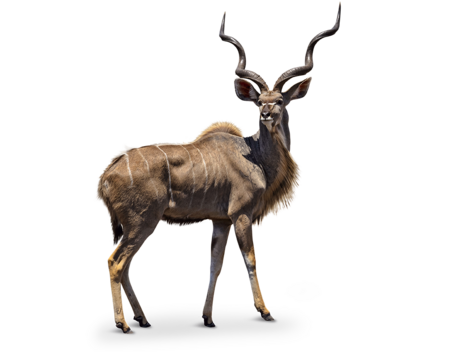Greater kudu
Tragelaphus strepsiceros
- Family
- Bovids (Bovidae)
- Weight
- ♀ 150 – 215 kg, ♂ 220 – 310 kg
- Habitat
- Savannahs, forests, scrublands, grasslands
Clear warning signals
When danger is sensed, greater kudus stand motionless in the bushes, which makes them difficult to spot. If that fails, they will flee rapidly in bounding leaps. As they flee, they raise their tails to make the white underside visible as a warning signal to other members of the herd. They may also emit a barking alarm call, which is one of the loudest calls of any African antelope.

Safe hiding place
After nine months of gestation, a female greater kudu typically gives birth to a single young. For the first 4 to 5 weeks, the mother leaves her newborn hidden in high grass where it must lie quietly in her absence to avoid predation. During this period, the mother returns three to five times a day to suckle it, but only for a few minutes each. Once the calf is strong enough, it will begin to join the herd, starting with short periods during the day.
The horns of a male greater kudu grow at about a ½ twist per year. A six-year-old buck has 3 twists, at which stage the horns are fully grown.
Distribution


Hellabrunn participates in the European Studbook